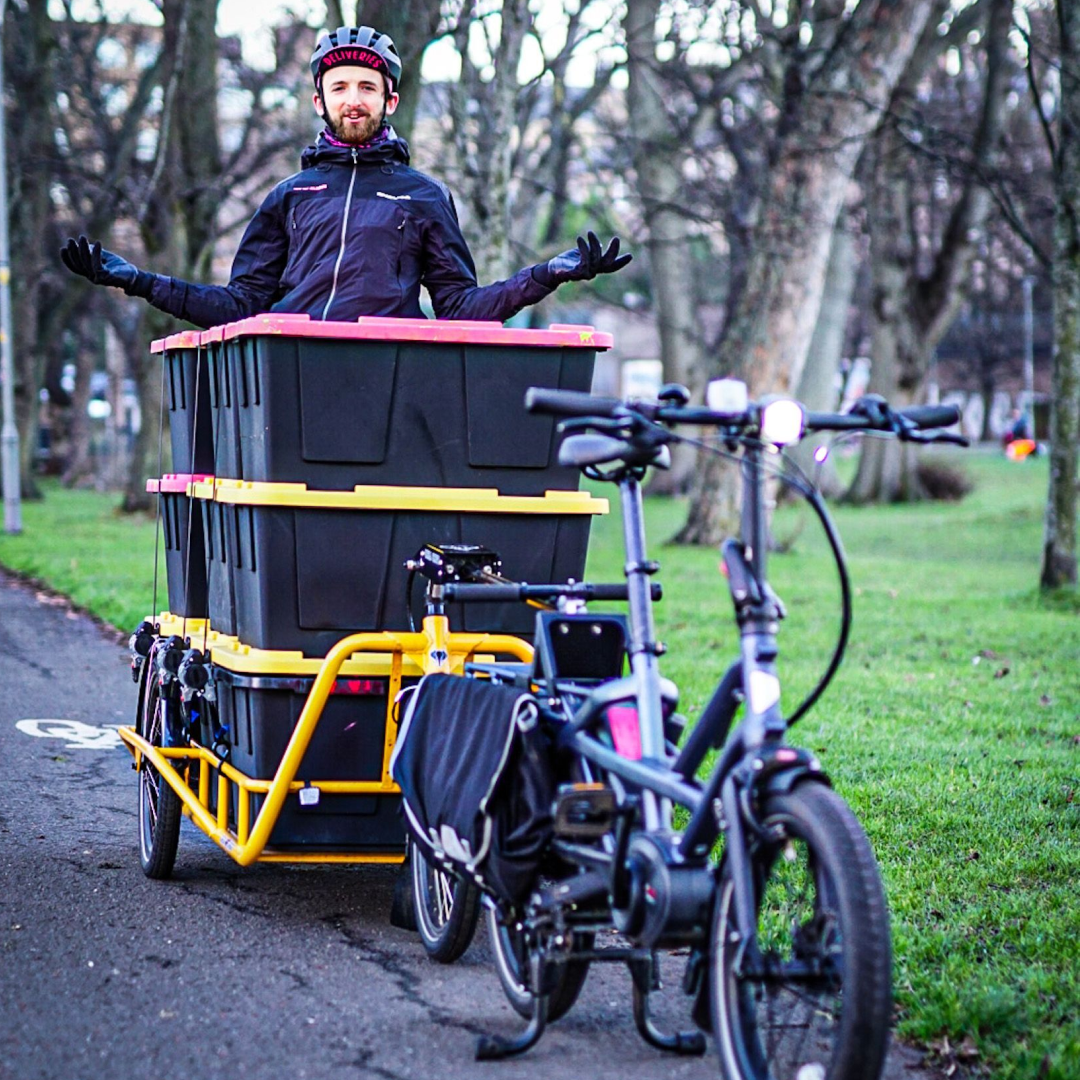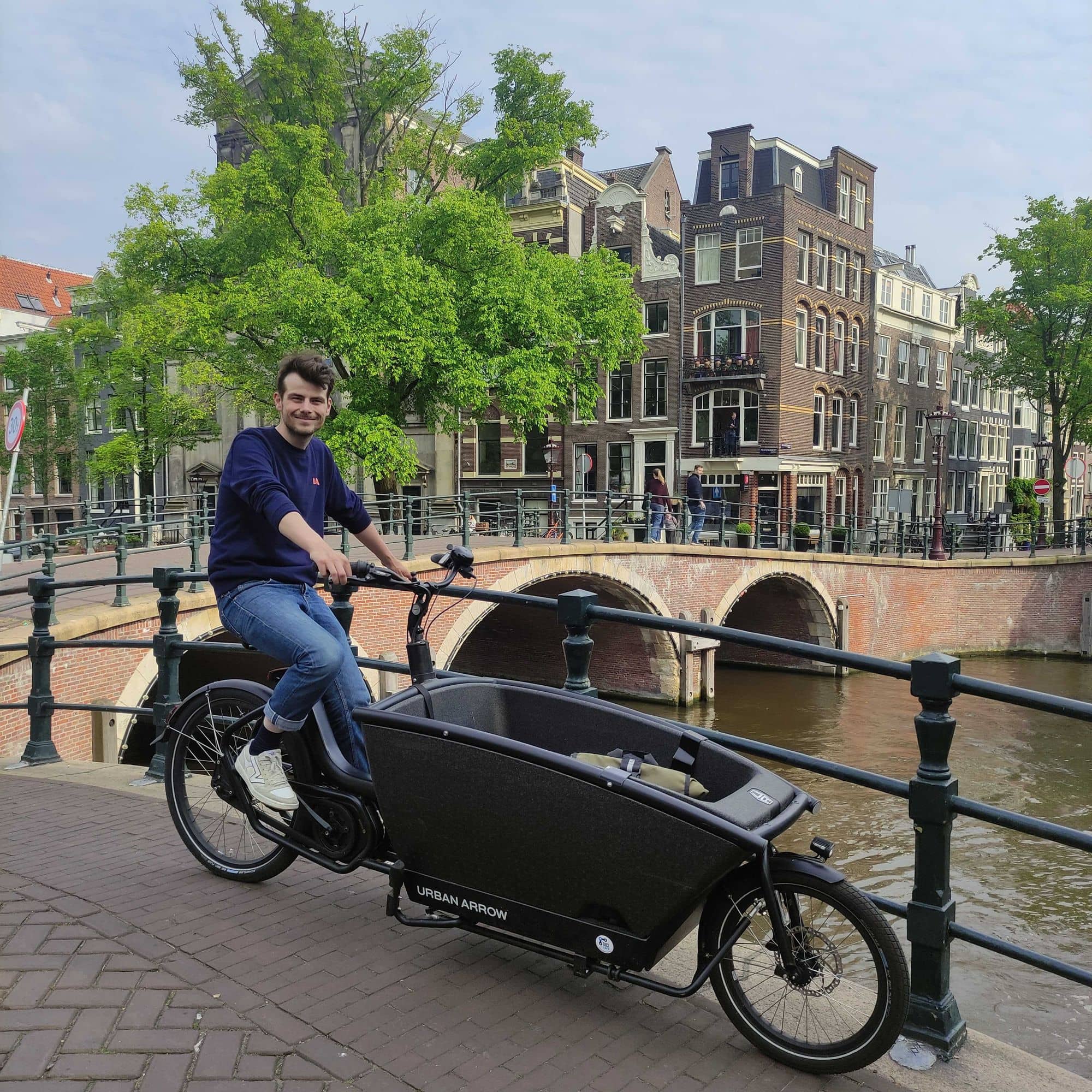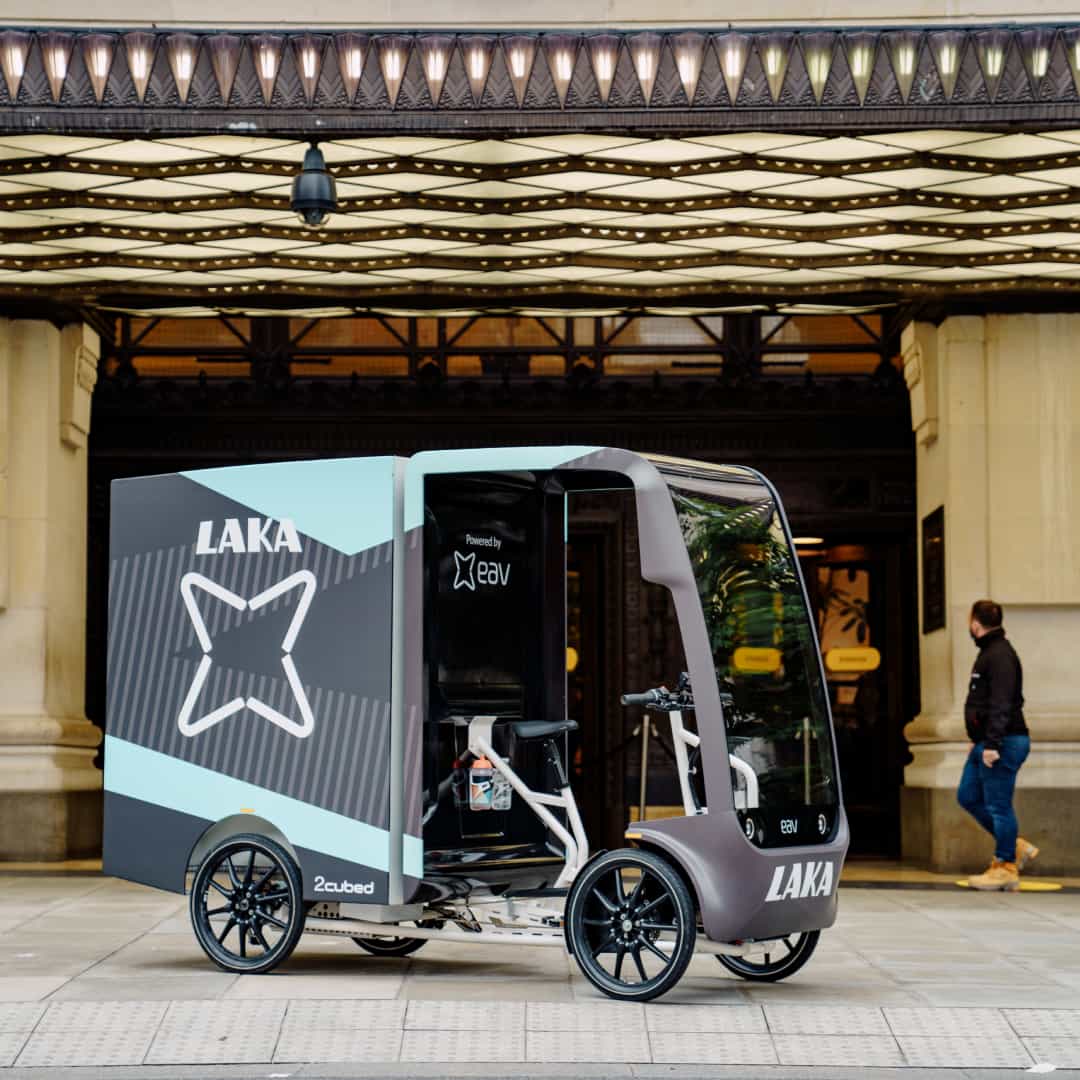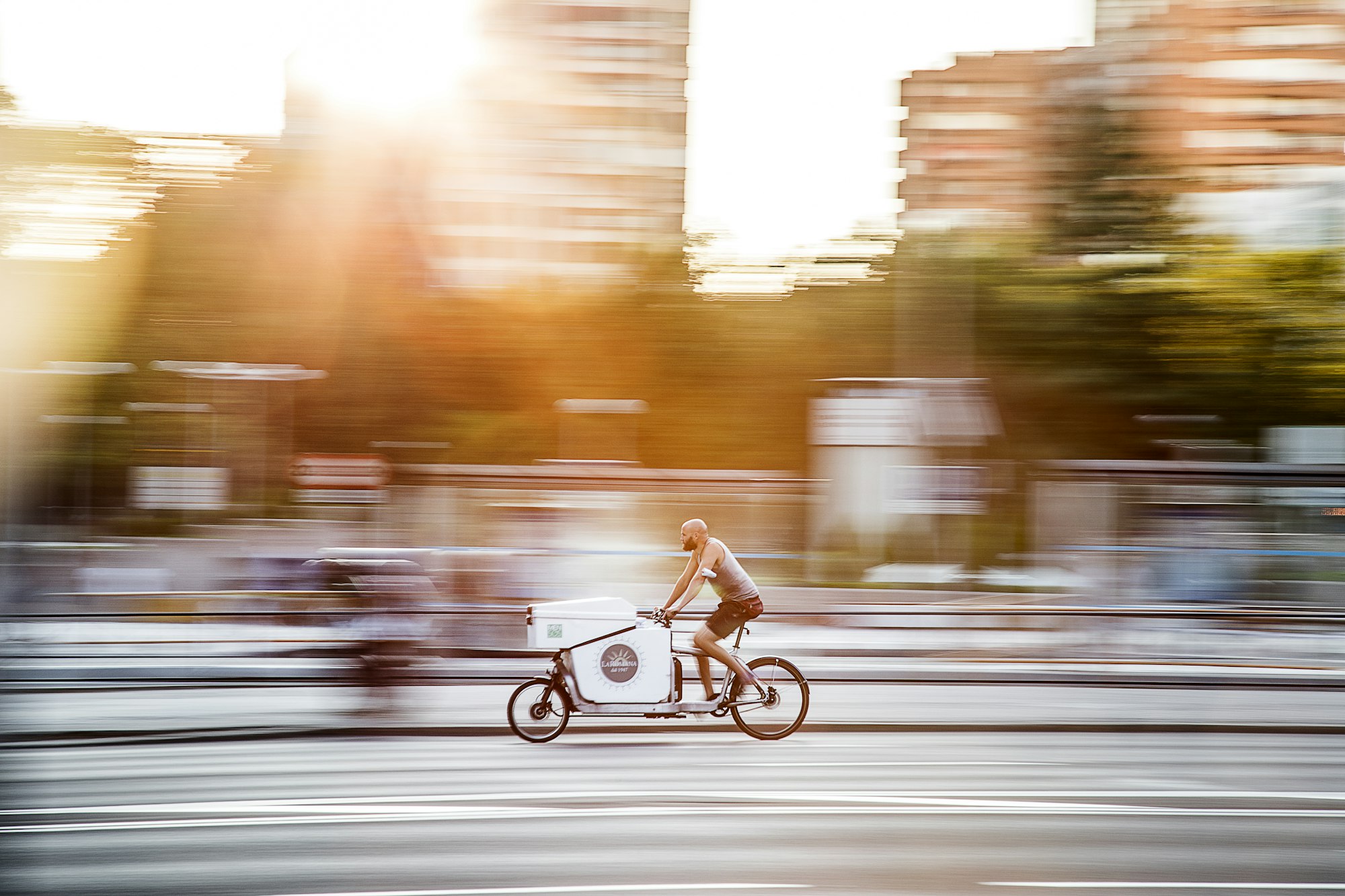I took a trip to visit e-bike specialists Fully Charged in Cornwall to discover more, and find out why there’s more to cargo bikes than just the urban grocery shop.
Cargo bike 101: all you need to know about loaded bikes
What is a cargo bike?
A cargo bike is a specialised bicycle designed to carry heavy loads. That could be taking your kids on the nursery or school run, carrying your tools (and you) to work, doing your weekly grocery shop, pedalling out to gorgeous nature spot to walk your dog, delivering goods locally or even moving house!
Some people use a cargo bike to replace a car for local journeys, while a growing number of courier companies use cargo bikes as an effective replacement for vans in inner city areas. In fact, that’s where cargo bikes originated in the early 19th century, when they were used to deliver bread, milk and mail.
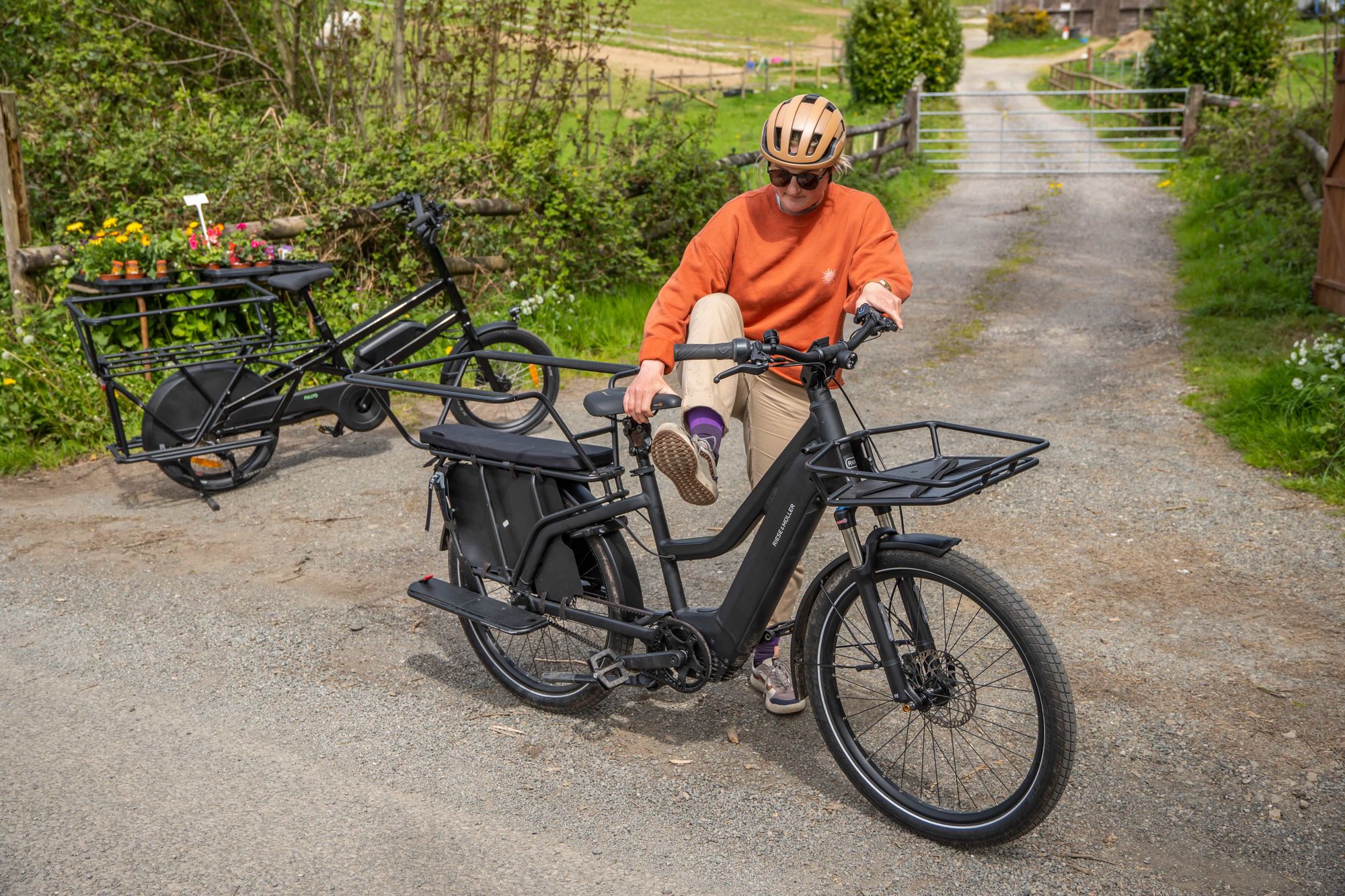
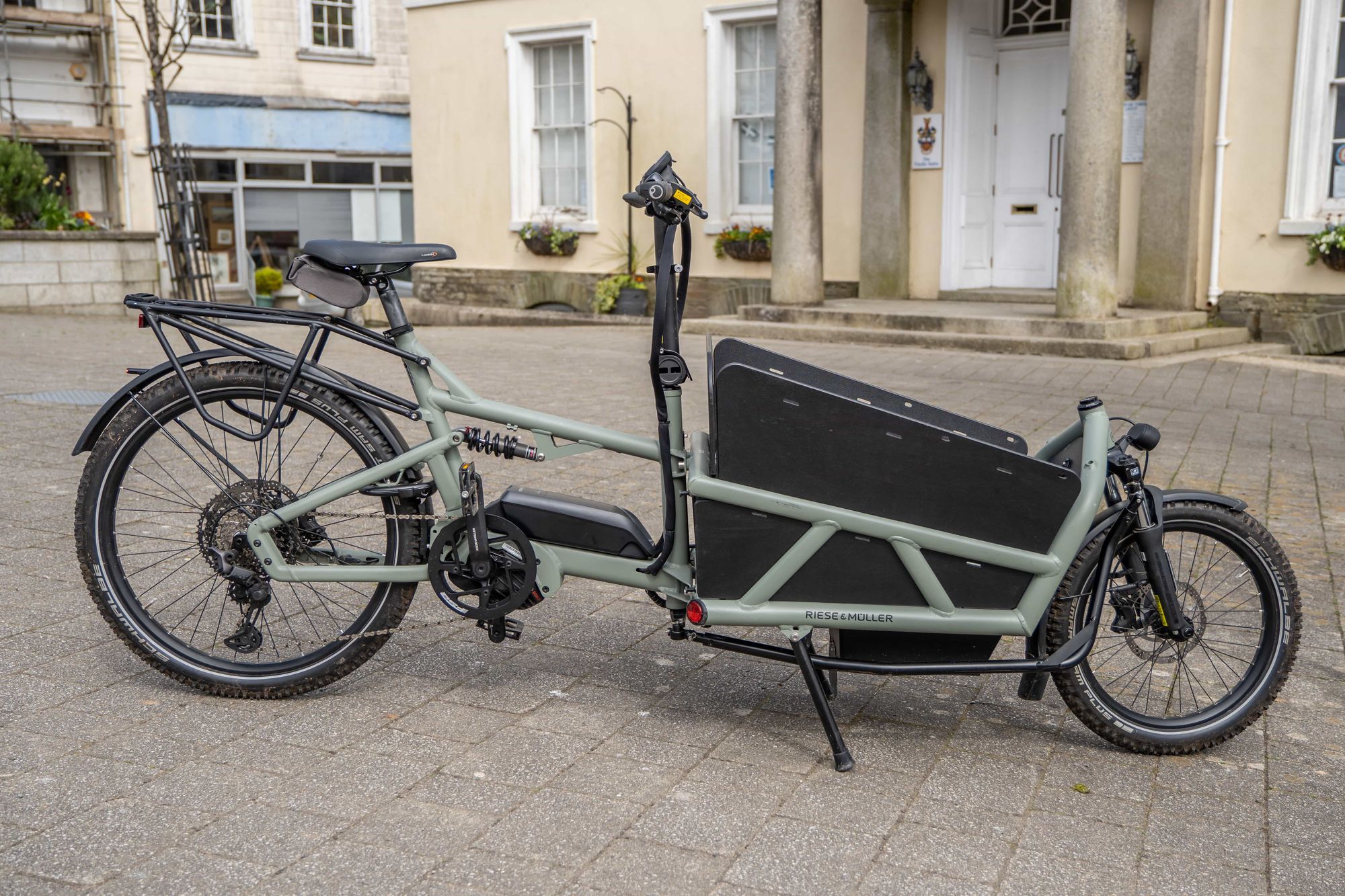
What different types of cargo bikes are there?
Commercial vs domestic
Generally speaking, there are a few different categories of cargo bikes on the market today. The first major distinction is between cargo bikes for commercial and domestic use.
Commercial cargo bikes, often designed to carry huge loads, are being used to replace some courier services in inner city areas. Reduced traffic congestion, air and noise pollution and fossil fuel dependency are major benefits to this switch.
In addition, a study in 2021 analysing trips made by London-based courier Pedal Me found that cargo bike deliveries were on average 1.61 times faster than a courier van. Cargo bikes proved to be able to navigate the busier urban streets more efficiently, making use of cycle lanes and streets closed to larger vehicles.
Front-loading vs back-loading
Cargo bikes designed for domestic use can be divided into two major types; back-loading and front-loading cargo bikes.
Back-loading cargo bikes, also known as long tails, are most similar to a conventional bicycle in terms of design and how easy they are to ride. These feature a longer wheelbase, with an extended design from the bottom bracket to the rear wheel so you can carry your cargo behind the rider.
These are best suited for carrying older children who can straddle the rear seat and cargo. Popular examples include the Tern GSD, Riese & Müller Multitinker, Benno Boost and the Moustache Lundi.
Front-loading cargo bikes are often designed to carry greater loads, with a platform or bucket in front of the rider and the front wheel placed further in front compared to a conventional bike.
Some of these feature child seats or benches, which can be adapted to suit children of different ages, and are generally better for carrying bulkier cargo. Plus, you can easily secure it with a rain cover for inclement weather.
The Riese & Müller Load4, Urban Arrow Family, Omnium Cargo, Larry vs Harry Bullitt and the Raleigh Stride are all examples of front-loading cargo bikes.
You can also get three, or even four wheeler cargo bikes, though they’re less common.
What are the benefits of owning a cargo bike?
There are a whole host of benefits of using a cargo bike. The human-powered transport can not only save you a whole heap of cash when it comes to switching out for using a car, but the health and wellbeing benefits are also considerable.
As cargo bikes are either totally pedal-powered or use electricity for assistance, there is no air pollution at the point of use. If you use a green energy supplier or have your own solar panels for battery charging then your cargo bike use will be even more environmentally-friendly. Besides not contributing to atmospheric pollutants or noise pollution, cargo bikes can also help to reduce congestion on busy urban routes.
The electric doesn’t do all the work though, so you can expect to benefit from some regular low to mid-intensity exercise. Guidelines from the UK Chief Medical Officers include at least 150 minutes of mid-intensity exercise per week, or just over 20 minutes per day, which could easily be achieved during a regular commute, school run or other errands on the cargo bike. Transport and exercise in one, bingo!
‘Apart from all that, it’s just fun’ admitted Chris Childs, founder of Fully Charged Cornwall. ‘To get to work with a smile on your face with some fresh air and exercise and just not sit in traffic. The kids love them, and the school run where you just see the traffic jams outside the school just doesn't have to be.’
How much load can you take?
Most cargo bikes are rated to take between 170kg and 250kg, including the bike itself, which is usually around 30kg, plus the rider and cargo. Family cargo bikes are typically rated to 200kg, usually with a 70kg load on the back or front. Enough for a couple of kids and school bags or skateboards at least!
Standard or electric, which type of cargo bike is best?
Almost all cargo bikes are electric, giving you additional assistance as you pedal to help offset the additional weight of cargo and the bike. While a standard cargo bike may be more affordable and suitable in flatter areas, electric cargo bikes come highly recommended in where the terrain is more hilly.
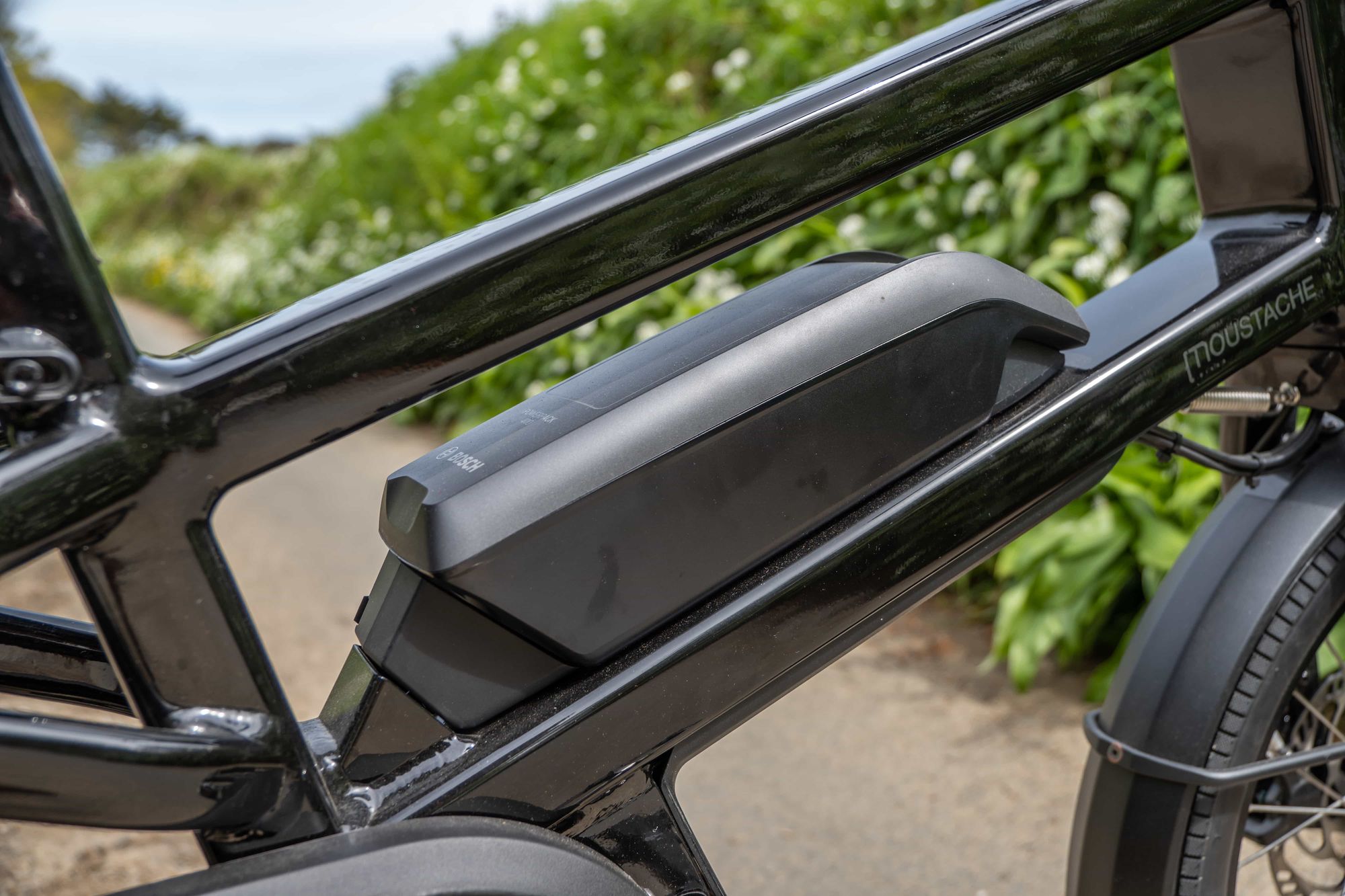
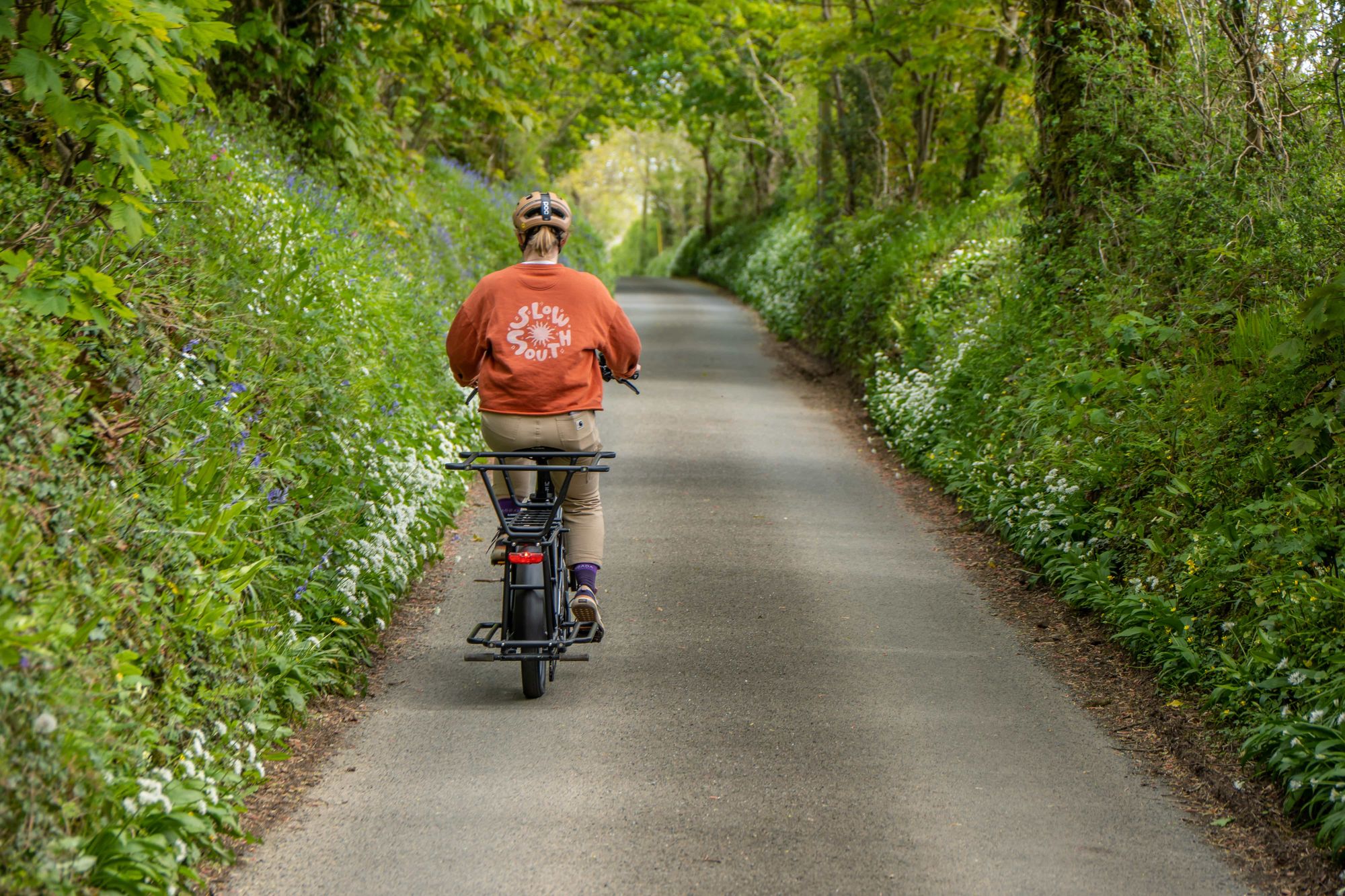
How easy is it to ride a cargo bike?
Designed with a very different purpose in mind, riding a cargo bike is certainly a very alternative experience to a conventional bike. I had the joy of testing a couple of front-loading and rear-loading cargo bikes from Fully Charged to offer up my thoughts as a cargo bike first-timer.
The riding experience of a rear-loading bike is most similar to a conventional ride, as the steering up front remains largely the same. I trialled the Moustache Lundi 20.3 Dual and the Riese & Muller Multicharger.
Once you get used to the simple electric controls and gearing, these really are a straightforward ride. Even unloaded, the electronic assistance was a real boon on the steep Cornish lanes and it was easily adjusted from the cockpit while riding along.
The front-loading bikes took a little more getting used to, as the front wheel is positioned much further forward than on a conventional bike which affects the steering and handling. I rode the Riese & Müller Load4 60 Vario, which features a large front box and full suspension for a very comfortable ride.
Despite a wobbly start, I’d say it took just 30 minutes of riding around the streets of Liskeard before I was more confident riding the Load4, bumping up curbs and turning into side streets without hesitation.
After a couple of hours of riding around town on a warm spring day I didn’t feel sweaty, which was thanks to the assistance of the e-bike motors. Being able to get across town or to work without feeling the need to shower or change outfits is a big plus and often cited as a barrier for people using a bike for shorter journeys such as commuting.
I asked Chris about handling the cargo bikes when loaded. ‘The smaller wheels give a lower centre of gravity, and when they’re loaded they do take a bit of getting used to but because of the way they’re designed it’s easy to put your feet down.’
‘I’ve had mine with a dog in, kids in the trailer on the back too, it’s great’.
From trying a few different bikes, I’d say that test riding a few different options before you commit to spending out on a cargo bike is a really good idea, and something that most retailers should be able to help you with.
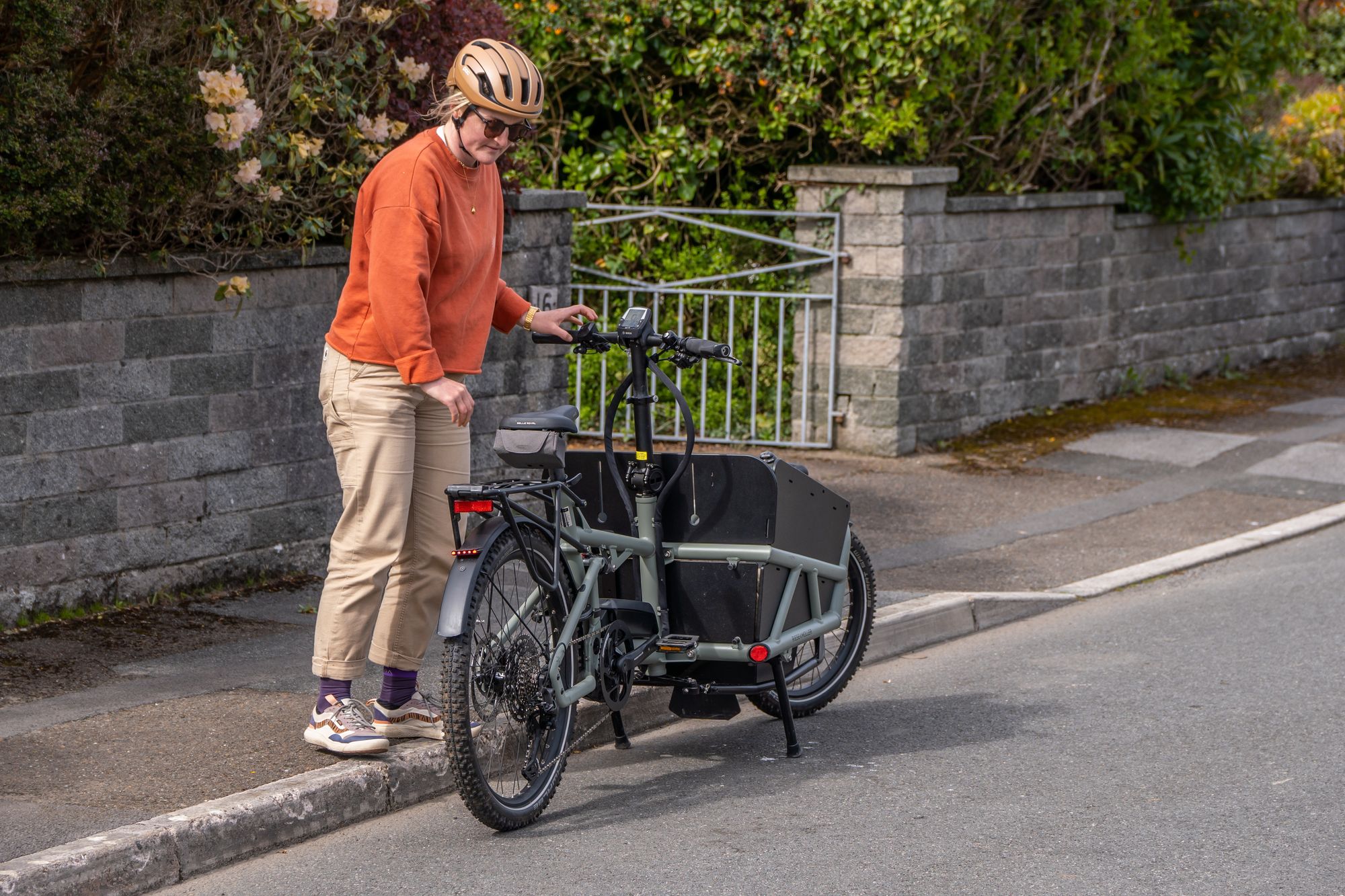
How do you service and maintain a cargo bike?
Just like owning a car, getting a regular service by a trained specialist is important to keep your cargo bike running smoothly.
‘It’s still a bike,’ Chris explained, ‘so it’s certainly feasible for someone who’s mechanically minded to do certain jobs, like replacing brake pads, but you really should take it to a specialist at least once a year.’
Electric cargo bikes will demand a more thorough routine inspection. ‘With the electrics there’s all sorts of diagnostic equipment that a specialist will have to make sure everything is running as it should.’
How can you store a cargo bike?
There’s no getting away from the fact that cargo bikes are large and bulky, especially with the front-loading style. However, if storage space is limited, then a few brands have come up with some handy design features to help you.
The rear-loading Tern GSD can be stored vertically on its back end, resting on the rack, so it can be stowed in a relatively small space like a hallway cupboard or storage room. The Moustache Lundi 20.3 compact eCargo bike can also be stored upright, as well as fit into an elevator.
If inside storage is a no-no, you can buy a dedicated wooden or steel security container for your garden or driveway. It’s best to secure it with a quality lock that’s Sold Secure Gold or Diamond rated.
What accessories or features might you expect to find on a cargo bike?
All cargo bikes will feature a kickstand, which keeps your bike upright and stable when you stop, allowing you to easily add your shopping or lift kids out without worrying about the bike tipping over.
Some bikes will have an inbuilt lock, which typically secures around the rear wheel. This makes it harder to simply take away, though you should also lock the cargo bike to an immovable object like a bike rack, ideally using a high quality Sold Secure Gold or Diamond rated lock.
Other accessories you can buy include child seats, foot rests, dog leads, locks, rain covers, cargo nets and storage for kit including panniers, crates, baskets and other bags.
How does using a cargo bike compare to using a car, price-wise?
If you’re looking at using a cargo bike to replace some, or all, of your car journeys, then you might be interested to learn more about how cost-efficient they can be.
Of course, the initial outlay for the bike will not be small; cargo bikes range from around £2,000 to £9,000 (or even more for some commercial models). You may be able to purchase your cargo bike using one of the cycle to Work schemes, which can save you up to 40% depending on your tax bracket.
After that, there’s the cost of regular servicing and replacement parts, and charging. The good news is that you can forget emissions tax, parking tickets, low emissions zones fees and a yearly MOT!
Recent estimates place the cost of running a car in the UK at £3,556, with fuel averaging £1,435 a year, insurance at £484, maintenance at £273 and other expenses including tax, parking and permits at £259.
In contrast, Fully Charged estimates the annual running cost of a Riese & Müller Tinker2 at £522.70. That includes £120 for an annual service, £57.72 in charging costs, £14.98 on some replacement inner tubes and £330 for 12 months of Laka bike insurance (including a month free using the Fully Charged discount code).
Do I need specialist insurance for a cargo bike?
Bike insurance isn’t mandatory in the UK (although if you’re using a cargo bike for commercial use you should check you have the right coverage).
But even if cargo bike insurance isn’t required by law you’ll want some form of protection. Especially as cargo bikes can often cost north of £3,000.
As for whether specialist insurance is right for you? Well we always stress to check your policy details.
Whilst the cheap quotes found online from home insurers can be tempting, there’s often numerous restrictions with hefty excesses, poor customer service and a lack of coverage.
A specialist insurer, like ourselves, will have expertise in the specific risks and challenges of owning and using a cargo bike. And will be able to provide you with the exact cover you need.
Not to mention when something goes wrong, with Laka you’ll deal with cargo bike experts who can get your wheels back rolling ASAP.
If you’re looking for flexible, customer-focussed, and award-winning cargo bike cover, look no further!
Learn more about our cargo bike insurance
Discover what's covered and how much it costs to insure your cargo bike by hitting the link below.



